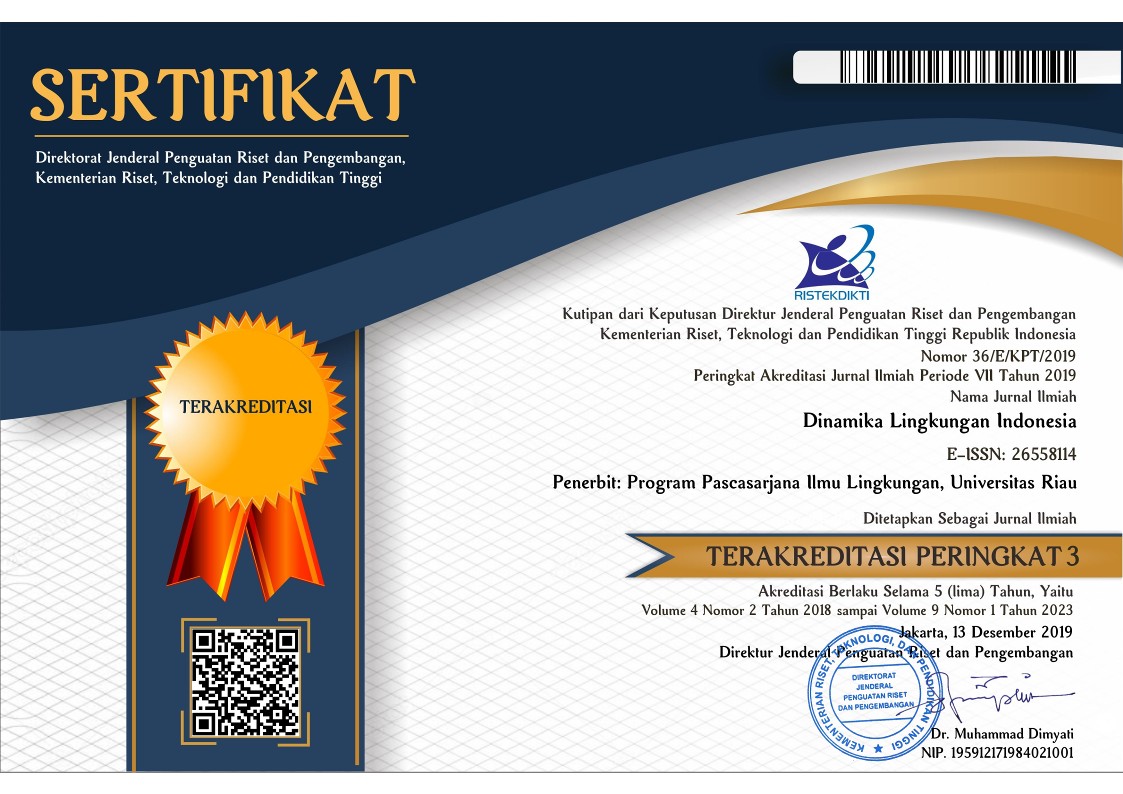Pengaruh perbedaan konsentrasi olahan air lindi terhadap kelimpahan Chlorella sp
Abstract
Leachate, as liquid waste is rich in nutrients, can be used as organic material for the microalgae culture such as Chlorella sp. This study aims to determine the effect of different concentrations to of leachate on the abundance of Chlorella sp populations. The observation was conducted at the laboratory of Microalgae, Agriculture faculty, Islamic University of Riau. The method used in this study was an experimental method using a randomized design; one factor, namely the different concentrations of leachate with five levels, were 5%, 10%, 15%, 20%, and 25%/l of water and three replications. The testing organism in this study was phytoplankton Chlorella sp. The culture container used was a gallon with 20 L of capacity and a water volume of 16 L. The measured parameters were cell abundance, specific growth rate, and water quality. The obtained results showed that the highest abundance of Chlorella sp at a concentration of 25% at 7,322,222 cells/ml, and the peak on day 16, the lowest concentration of 5%, was 2,580,556 cells/ml. On the sixth day, the highest specific growth rate was at a concentration 5% at 0.195/day, and the lowest was 20% at 0.077/day.
Keywords
Full Text:
PDFReferences
Acivedo, S., Pino, N.J., & Panuela, G.A. (2017). Biomass Production of Scenedesmus sp. and Removal of Nitrogen and Phosphorus in Domestic Wastewater Remocion de Nitrogeno, fosforo by Produccion de Biomasa de Scenedesmus sp. en Agua Residual Domestica. Environmental Engineering. 193 (1): 185-193. http://www.scielo.org.co/scielo.php?script=sci_arttext&pid=S0123-30332017000100185.
Aprilliyanti, S., Soeprobowati, T.R & Yulianto, B. (2016). Hubungan Kemelimpahan Chlorella sp Dengan Kualitas Lingkungan Perairan Pada Skala Semi Masal di BBBPBAP Jepara. Jurnal Ilmu Lingkungan. 14 (2): 77-81. https://doi.org/10.14710/jil.14.2.77-81.
Aulia, M., Istirokhotun, T & Sudarno. (2017). Penyisihan Kadar COD dan Nitrat Melalui Kultivasi Chlorella sp dengan Variasi Konsentrasi Limbah Cair Tahu. Jurnal Teknik Lingkungan. 6 (2): 1-9. https://www.neliti.com/id/publications/140791/penyisihan-kadar-cod-dan-nitrat-melaluikultivasi-chlorella-sp-dengan-variasi-kon.
Avivi, S., Suyani, I.S & Winarso, S. (2010). Efek Bakteri Pelarut Fosfat Terhadap Pertumbuhan Aspergillus flavus Pada Perkecambahan Kacang Tanah. Jurnal HPT Tropika. 10 (1): 64-72. https://doi.org/10.23960/j.hptt.11064-72.
Banerjee, S., Hew, W.E., Khatoon, H., Shariff, M & Yusoff, F.M. (2011). Growth and Proximate Composition of Tropical Marine Chaetoceros calcitrans and Nannochloropsis oculata Cultured Outdoors and Under Laboratory Conditions. African Journal of Biotechnology. 10 (8): 1375-1383. https://www.ajol.info/index.php/ajb/article/view/92946.
Boroh, R., Litaay, M., Umar, M.R & Ambeng. (2019). Pertumbuhan Chlorella sp. Pada Beberapa Kombinasi Media Kultur. Bioma: Jurnal Biologi Makassar. 4 (2): 129-137. https://doi.org/10.20956/bioma.v4i2.6759.
Dimiati, D.D & Hadi, W. (2017). Uji Pemanfaatan Pupuk Organik Cair Lindi dengan Penambahan Bakteri Starter Terhadap Pertumbuhan Tanaman Hortikultura (Solanum melongena dan Capsicum frutescens). Jurnal Teknik ITS. 6 (2): 349-354. 10.12962/j23373539.v6i2.25199.
Gustianysah. (2020). Siklus Fosfor: Pengertian, Peranan, Sifat, Proses dan Manfaatnya. https://failfaire.org/siklus-fosfor. Diakses, Maret 2021.
Istirokhatun, T., Aulia, M & Sudarno. (2017). Potensi Chlorella sp Untuk Menyisihkan COD dan Nitrat Dalam Limbah Cair Tahu. Jurnal Presipitasi. Media Komunikasi dan Pengembangan Teknik Lingkungan.14 (2):88-96. https://doi.org/10.14710/presipitasi.v14i2.88-96.
Liu, L., Wenyu, L., Yichen, Z., Jing, Z., & Fujie, Z. (2015). Effect of Nitrogen-containing Compounds on Growth Characteristic of the Oleaginous Microalga Chlorella ellipsoidea. Electronic Journal of Biology. 11 (1): 1-7.https://ejbio.imedpub.com/effect-of-nitrogencontaining-compounds-on-growth-characteristic-of-the-oleaginous-microalga-chlorella-ellipsoidea-sd0701.php?aid=6012.
Meriatna., Suryati & Fahri, A. (2018). Pengaruh Waktu Fermentasi dan Volume Bio Aktivator EM4 (Effective Microorganisme) pada Pembuatan Pupuk Organik Cair (POC) dari Limbah Buah-Buahan. Jurnal Teknologi Kimia. 7 (1): 13-29. https://doi.org/10.29103/jtku.v7i1.1172.
Meritasari, D., Mubarok, A.S., Sulmartiwi, L & Masithah, E.D. (2012). Pengaruh Pemberian Pupuk Cair Limbah Ikan Lemuru (Sardinella sp) Dengan Dosis yang Berbeda Terhadap Pertumbuhan Chlorella sp. Jurnal Ilmiah Perikanan dan Kelautan. 4 (1): 27-32. http://dx.doi.org/10.20473/jipk.v4i1.11579.
Mujiatul, M. (2013). Peningkatan Kadar N, P dan K Pada Pupuk Cair Limbah Tahu Dengan Penambahan Tanaman Matahari Meksiko (Thitonia diversivolia), Skripsi. Universitas Negeri Semarang, Semarang.
Mukhlis, A., Abidin, Z & Rahman, I. (2017). Pengaruh Konsentrasi Pupuk Amonium Sulfat Terhadap Pertumbuhan Populasi Sel Nannochloropsis sp. Jurnal Biowallacea Jurnal Ilmiah Ilmu Biologi. 3 (3): 149-155.
Peraturan Menteri Pertanian. 2011. Nomor. 70/Permentan/SR.140/10/2011. Tentang Pupuk Organik, Pupuk Hayati dan Pembenah Tanah. 109 hal.
Peraturan Menteri Lingkungan Hidup dan Kehutanan Republik Indonesia. 2016. Nomor. P.59/Menlhk/Setjen/Kum.1/7/2016. Tentang Baku Mutu Lindi Bagi Usaha dan/atau Kegiatan Tempat Pemrosesan Akhir Sampah. 12 hal.
Prabowo, D.A. (2009). Optimasi Pengembangan Media Untuk Pertumbuhan Chlorella sp Pada Skala Laboratorium. Program studi Ilmu dan Teknologi Kelautan Fakultas Perikanan dan Ilmu Kelautan. Institut Pertanian Bogor. Bogor. 108 hal.
Richmond, A. (2004). Biological Principles of Mass Cultivation. In: Richmond A, editor. Handbook of Microalgal Culture: Biotechnology and Applied Phycology. Blackwell Publishing Ltd. London. pp. 125-177.
Steel, R.G.D. & Torrie, J.H. (1993). Prinsip dan Prosedur Statistika. Suatu Pendekatan Masalah Biometrik. Gramedia, Jakarta.
Sugiharto. (2020). Chlorella vulgaris dan Spirulina platensis: Kandungan Nutrisi dan Senyawa Bioaktifnya Untuk Meningkatkan Produktivitas Unggas. Wartazoa. 30 (3): 123-138.
Sulistiono, E. (2018). Pengolahan Limbah Cair Tahu Dengan Menggunakan Effective Microorganism Organik (EM4 Organik). Jurnal Pengabdian Masyarakat. 1 (1): 22-28. https://doi.org/10.30736/jab.v1i01.30.
Sylvester, B., Nelvy, D & Sudjiharno. (2002). Biologi Fitoplankton, Budidaya Fitoplankton dan Zooplankton. Balai Budidaya Laut Lampung. Makara, Teknologi. 9: 3-23.
Tambaru, R. (2008). Dinamika Komunitas Fitoplankton Dalam Kaitannya Dengan Produktivitas Perairan di Perairan Pesisir Maros Sulawesi Selatan. Disertasi. Pasca Sarjana IPB. Bogor. (tidak diterbitkan).
Widiyanto, A., Susilo, B & Yulianingsih, R. (2014). Studi Kultur Semi-Massal Mikroalga Chlorella sp Pada Area Tambak Dengan Media Air Payau (Di Desa Rayunggumuk, Kecamatan Glagah, Kabupaten Lamongan). Jurnal Bioproses Komoditas Tropis. 2 (1): 1-7. https://jbkt.ub.ac.id/index.php/jbkt/article/view/127.
Widyantoro, H., Wijayanti, M & Dwinanti, S.H. (2018). Modifikasi Media Spirulina platensis Sebagai Upaya Pemanfaatan Air Limbah Budidaya Ikan Lele. Jurnal Akuakultur Rawa Indonesia. 6 (2): 153-164. https://doi.org/10.36706/jari.v6i2.7159.
Wood, A.M., Everroad, R.C & Wingard, R.M. (2005). Measuring Growth Rates in Mikroalgal Cultures. In: Algal Culturing Techniques (Andersen, R.A. Ed). Elseviers Acad. Press. pp. 269-284.
DOI: http://dx.doi.org/10.31258/dli.9.1.p.32-38
Refbacks
- There are currently no refbacks.





